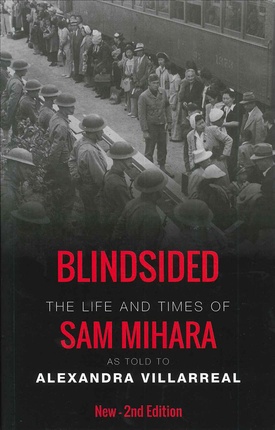In 2019, Paramount released the biopic feature film on British rock singer Elton John entitled Rocketman. Sam Mihara’s slender and well-written autobiographical book, Blindsided, also showcases the life of a rocket man. It, too, could have been titled Rocketman. After all, upon completing his undergraduate and graduate engineering degrees at the University of California, Berkeley and UCLA, Mihara enjoyed a distinguished 42-year career at Boeing as a rocket scientist.
Then, 14 years after his 1997 retirement, he forged a new career, one which saw him rocketing around the entire country giving talks about mass incarceration in the U.S. to audiences exceeding 60,000 and reaching students, teachers, lawyers, libraries, museums, and other institutions.
Mihara’s presentations are rooted in his three-year World War II incarceration experience as a San Francisco born-and-bred pre-teen Nisei inmate within the Pomona Assembly Center in Los Angeles County and the Heart Mountain incarceration camp in northwest Wyoming.
In the opening three-fourths of his book, Mihara first provides a riveting account of his pre-World War II life in San Francisco’s Japantown, where his father was a writer for the bilingual New World Sun newspaper and his family lived in an upscale Victorian home. He then bitingly depicts the Mihara family’s incarceration at Pomona — “A purgatory that looked more like hell than heaven. … a world where we were animals with perhaps less respect than the prize mares that came before us at this racetrack” (pp. 23) — and Heart Mountain — “We were prisoners. Tucked away in Wyoming’s expanse, we were forgotten by the outside world. No one cared what happened to us, and no one fought for justice” (pp. 31).
In the remainder of his book, Mihara concisely covers his family’s resettlement experience in a low-income neighborhood of Salt Lake City, in which diverse ethnic communities clashed and the Miharas found “racial slurs or worse graffitied on our rental house” (pp. 71).
He next relates his postwar education upon the family’s return to San Francisco and his education at Lick-Wilmerding High School and the University of California, Berkeley (a fallback choice because his family could not fund his matriculation at the Massachusetts Institute of Technology), and his courtship and marriage to Helene Hideno Nakamoto.
He then turns his resolute attention to his second career as arguably “the only survivor of the camps touring the United States to talk about what we lived and witnessed” (pp. 95). But, notes Mihara, in his talks, he also unfailingly addresses the pernicious detention of non-Japanese American groups in contemporary America, particularly refugees entering our southern border seeking asylum. Although he has long ago forgiven America for what it did to him and his family, Mihara refuses to let Americans forget it. For if we should do so, he cautions, future generations will judge us harshly.
Blindsided deserves to be adopted by school systems nationwide for consumption by adolescent students. It also merits the rapt attention of general readers of every age who are unfamiliar with the Japanese American World War II story and the related stories of other unjustly oppressed communities within our country.
BLINDSIDED: THE LIFE AND TIMES OF SAM MIHARA
By Sam Mihara, as told to Alexander Villarreal
(Self-published, 2019, 2nd Ed., 121 pp., $20, paperback)
* This article was originally published by Nichi Bei Weekly on July 16, 2020.
© 2020 Arthur A. Hansen; Nichi Bei Weekly








